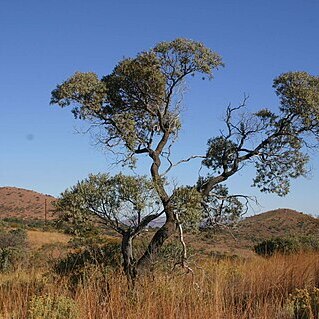Leaves simple, stalked, alternate, oblong-lanceolate or lanceolate, acute or obtuse, mucronate, margined, undulate-crenate, glabrous above save on the pubescent nerves, silky-tomentose beneath, penninerved on both sides; panicles terminal, much longer than the leaves; pedicels, calyx, and petals outwardly silky-canescent; drupe sub-globose, sub-fleshy. A shrub, very similar to the preceding, but known by the undulate and crenulate in the upper surface not adpressed-pubescent leaflets, and the compound, long panicle. Leaflets about the same size as those of R. salvana, 2.5-3 inches long, 8-10 lines wide; the upper ones smaller. Panicles longish, pedunculate, silky-tomentose, flowers sub-glomerate, about 2 lines long. Petals oblong, twice longer than the acute calyx and the stamens. Ripe fruit wanting.
A small shrub. It loses its leaves during the year. It has several stems and keeps growing from year to year. It grows 10 m high. Male and female flowers are on separate plants. The flowers are small and creamy white. They are in heads at the ends of the branches. The flowers have a sweet scent. The fruit is fleshy and oval or kidney shaped. It is green but turns black as it ripens. It is 7 mm long by 10 mm wide.
Shrub or small tree, up to 6 m high. Leaves discolorous, midrib and lateral veins conspicuous on undersurface, narrowly elliptic, 40-120 x 10-40 mm, undersurface silvery to silky green with appressed hairs. Flowers white.
Much-branched shrub 0·6–3 m. tall, or small tree; branches brownish-red, cylindric, shortly pilose or puberulous when young, later glabrescent, densely leafy.
Panicles axillary and terminal, usually lax, from few-to many-flowered, with axis and branches puberulous.
Drupe black, somewhat shining, up to 7 × 11 mm., transversely ellipsoid, compressed.
Calyx-segments 2–2·25 mm. long, lanceolate-triangular, acute, puberulous outside.
Petals 3 × 1·5 mm., obtuse, rounded and flat at the apex.


